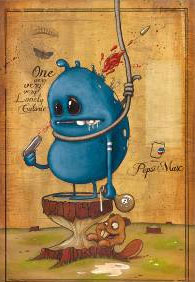Wieneke’s Law of Advertising: Death and Soft Drinks Don’t Mix
 Though traffic accidents still rivet the attention of passers-by, most companys wouldn’t want to sponsor the carnage. Its bad for brand.
Though traffic accidents still rivet the attention of passers-by, most companys wouldn’t want to sponsor the carnage. Its bad for brand.
That’s the basis of Wieneke’s First Law of Advertising: “Avoid associating your brand with death or terrible harm.”
This seems like obvious advice, but during just the first quarter of the most recent Super Bowl, we saw a guy get a snow globe in the testicles, another guy who got hit by a bus, an electrocution, a golf club to the head, a horrible ski accident and a low-level executive who gets thrown out a fourth-story window. Get a taste.
Harm Cuts Through the Clutter
Creative directors have the challenge of cutting through life’s clutter to arrest viewers’ attention. While cinema advertising catches them without other stimuli, the rest of the world is teeming with distraction.
So it takes extraordinary creative to stop consumers dead in their tracks and get them to pay attention. And it takes even more daring creative to generate the kind of buzz that gets consumers to talk about the ad. For several decades, that meant drawing on sex appeal. But increasingly, creatives are reaching for “death” or “embarassing harm” to seize viewers’ attention.
Does Suicide Sell?
The latest attempt is with Pepsi’s suicide-themed ads. The concept is that its new drink, PepsiMax (the first diet drink for men), has only one calorie. And that last, lonely calorie is looking to to die a violent death. Just what men want with their diet beverage. It’s may be a creative idea, but it’s also a hell of a callous way to sell soda. It tars the brand with death, which may be buzzworthy, but it’s not brand-worthy.
Volkswagon has a suicide jumper and suicide bomber ads. GM has an assembly robot jump off a bridge. Here’s an ad that sells tires with a suicidal dog. Not a one of them make me feel like going shopping. And mental health groups are particularly concerned about ads that portray suicide as entertainment.
Death Brands Are A Sign of the Times
We live in an uneasy time, when people watch autopsy dramas before bed. These entertainment brands are more “death-positive” than consumer goods.
BBDO, the agency that made Pepsi’s suicide ads, also did a series of fake body arms hanging out of trunks with bumper stickers advertising the television show The Sopranos. Court TV uses fun photos of murder scenes to promote its shows. Some of America’s Top Models pretend to be suicide victims as part of fashion shoots. Talk about glorifying violence against women.
Anyway, Wieneke’s Law is simple, but on the whole it’s good advice. Ads that hurt their spokespeople, show suicides, or belittle their customers may succeed in gaining notice, but they do so at the expense of the brand. Tarring your brand with harm isn’t just playing with fire; it’s playing with the kind of acid that can erode the luster of a strong brand, and make it seem dangerous, silly, or simply vile.
What do you think? Discussion is open on Facebook.
Does this stuff ever work? And what in our cultural mindset is it that is making “death and embarassing harm” an emerging theme in advertising just now?

 The future of digital experiences will be built by strategists who grasp the full array of emerging business, social, and technical models. Specialties in user experience, branding, application design, and data science are laying the foundation for richer user experiences and business models breakthrough products and revenue based marketing.
The future of digital experiences will be built by strategists who grasp the full array of emerging business, social, and technical models. Specialties in user experience, branding, application design, and data science are laying the foundation for richer user experiences and business models breakthrough products and revenue based marketing.
3 Responses to "Wieneke’s Law of Advertising: Death and Soft Drinks Don’t Mix"
October 4, 2011
[…] happens there’s almost always a regrettable story involving phrases like collateral damage. Wieneke’s first law of advertising: Unless you are selling The Sopranos, avoid associating your brand with death. Especially if your […]
October 3, 2012
[…] before you base a campaign on them. In this blog I’ve advocated avoiding connecting brands to death or pedophiles…so pigs are definitely less destructive that these. Even so, they do ad a cultural […]
November 10, 2015
[…] of ads, Suffolk University has too. In my opinion, they’ve strayed to the wrong side of Wieneke’s first law of advertising, not associating your project with death or terrible […]